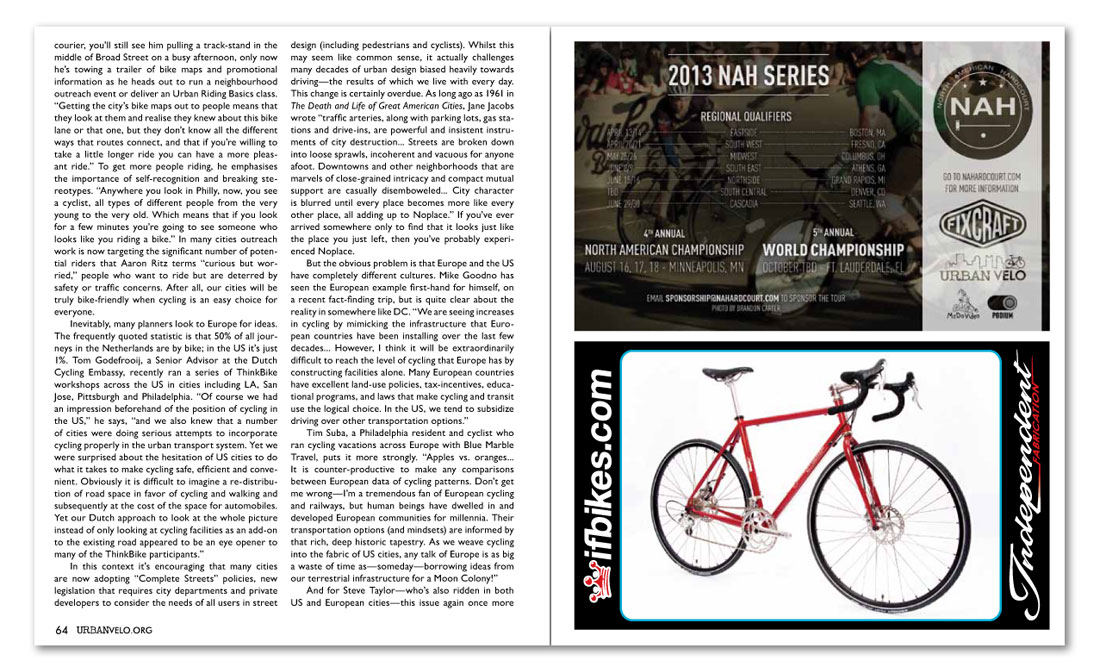


courier, you’ll still see him pulling a track-stand in the middle of Broad Street on a busy afternoon, only now he’s towing a trailer of bike maps and promotional information as he heads out to run a neighbourhood outreach event or deliver an Urban Riding Basics class. “Getting the city’s bike maps out to people means that they look at them and realise they knew about this bike lane or that one, but they don’t know all the different ways that routes connect, and that if you’re willing to take a little longer ride you can have a more pleasant ride.” To get more people riding, he emphasises the importance of self-recognition and breaking stereotypes. “Anywhere you look in Philly, now, you see a cyclist, all types of different people from the very young to the very old. Which means that if you look for a few minutes you’re going to see someone who looks like you riding a bike.” In many cities outreach work is now targeting the significant number of potential riders that Aaron Ritz terms “curious but worried,” people who want to ride but are deterred by safety or traffic concerns. After all, our cities will be truly bike-friendly when cycling is an easy choice for everyone.
Inevitably, many planners look to Europe for ideas. The frequently quoted statistic is that 50% of all journeys in the Netherlands are by bike; in the US it’s just 1%. Tom Godefrooij, a Senior Advisor at the Dutch Cycling Embassy, recently ran a series of ThinkBike workshops across the US in cities including LA, San Jose, Pittsburgh and Philadelphia. “Of course we had an impression beforehand of the position of cycling in the US,” he says, “and we also knew that a number of cities were doing serious attempts to incorporate cycling properly in the urban transport system. Yet we were surprised about the hesitation of US cities to do what it takes to make cycling safe, efficient and convenient. Obviously it is difficult to imagine a re-distribution of road space in favor of cycling and walking and subsequently at the cost of the space for automobiles. Yet our Dutch approach to look at the whole picture instead of only looking at cycling facilities as an add-on to the existing road appeared to be an eye opener to many of the ThinkBike participants.”
In this context it’s encouraging that many cities are now adopting “Complete Streets” policies, new legislation that requires city departments and private developers to consider the needs of all users in street design (including pedestrians and cyclists). Whilst this may seem like common sense, it actually challenges many decades of urban design biased heavily towards driving—the results of which we live with every day. This change is certainly overdue. As long ago as 1961 in The Death and Life of Great American Cities, Jane Jacobs wrote “traffic arteries, along with parking lots, gas stations and drive-ins, are powerful and insistent instruments of city destruction... Streets are broken down into loose sprawls, incoherent and vacuous for anyone afoot. Downtowns and other neighborhoods that are marvels of close-grained intricacy and compact mutual support are casually disemboweled... City character is blurred until every place becomes more like every other place, all adding up to Noplace.” If you’ve ever arrived somewhere only to find that it looks just like the place you just left, then you’ve probably experienced Noplace.
But the obvious problem is that Europe and the US have completely different cultures. Mike Goodno has seen the European example first-hand for himself, on a recent fact-finding trip, but is quite clear about the reality in somewhere like DC. “We are seeing increases in cycling by mimicking the infrastructure that European countries have been installing over the last few decades... However, I think it will be extraordinarily difficult to reach the level of cycling that Europe has by constructing facilities alone. Many European countries have excellent land-use policies, tax-incentives, educational programs, and laws that make cycling and transit use the logical choice. In the US, we tend to subsidize driving over other transportation options.”
Tim Suba, a Philadelphia resident and cyclist who ran cycling vacations across Europe with Blue Marble Travel, puts it more strongly. “Apples vs. oranges... It is counter-productive to make any comparisons between European data of cycling patterns. Don’t get me wrong—I’m a tremendous fan of European cycling and railways, but human beings have dwelled in and developed European communities for millennia. Their transportation options (and mindsets) are informed by that rich, deep historic tapestry. As we weave cycling into the fabric of US cities, any talk of Europe is as big a waste of time as—someday—borrowing ideas from our terrestrial infrastructure for a Moon Colony!”
And for Steve Taylor—who’s also ridden in both US and European cities—this issue again once more